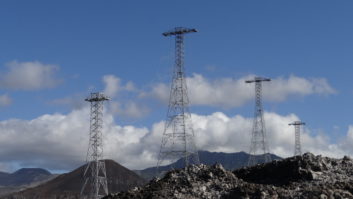GENEVA Seven years in the making, Digital Radio Mondiale has arrived.
Approximately 300 DRM proponents and international delegates to the International Telecommunication Union 2003 World Radiocommunication Conference gathered here for the flip of the digital switch in June. Voice of America was among them. Digital shortwave, medium-wave/AM and long-wave broadcasts launched when DRM chairman Peter Senger cued engineers at nearby Mount Saleve in France. Senger also is director of marketing, sales and technology for Deutsche Welle.
Deliberate effort
DRM founding members Thales Broadcast & Multimedia and Télédiffusion de France installed a Thales transmitter with DRM encoder/modulator on Mount Saleve, overlooking Geneva, for the launch broadcast.
International broadcasters taking part in the event included BBC World Service, Christian Vision, Deutsche Welle, Kuwait Radio, Radio Canada International, Radio France Internationale, Radio Netherlands Wereldomroep, Radio Vaticana, Sveriges Radio International, Voice of Russia and Wales Radio International.
National broadcasters DeutschlandRadio and Radio France; a local station in Nürnberg, Germany; and the Luxembourg-based RTL Group participated. Fraunhofer-Institut, Nozema, Telenor/Norkring, T-Systems Media&Broadcast and VT Merlin Communications also took part.
The idea for DRM began in 1996 when several international broadcasters and technology companies began discussions. The participants felt something had to be done to improve broadcasting below 30 MHz as many international broadcasters were scaling back or ending such transmissions due to poor audio quality compared to FM.
That mandate was set at a meeting in Guangzhou, China, in early 1998. Members of the DRM Consortium, now more than 80 broadcasters and technology companies, committed themselves to upgrading long-, medium-/AM and shortwave broadcasting below 30 MHz.
Endorsement
The ITU radio communication sector approved DRM specifications in April of 2001. The European Telecommunications Standards Institute published DRM technical specifications in September of that year. This cleared the way for broadcasters to test the system.
DRM uses aaaPlus audio coding. This format is a combination of MPEG advanced audio coding developed by Fraunhofer and a spectral band replication bandwidth extension algorithm developed by Coding Technologies.
The coder helps correct fading as propagation interference is minimized, DRM proponents say.
Savings
In a demonstration the week before the official launch at the European Broadcasting Union, transmissions from Russia, Canada, France, Portugal, the Netherlands, Germany, the United Kingdom and Kuwait were switched from analog to DRM.
Some broadcasters need to upgrade studios and facilities to take advantage of the digital framework, according to DRM proponents. Thales Broadcast Advanced Technologies Director Pierre Vasseur also said “content changes” were necessary for the full impact of DRM to be felt. However, the upgrade to DRM was quick, said Vasseur.
“From order to on-the-air in Kuwait took less than six months,” Vasseur said.
The Ministry of Information of the State of Kuwait modified a 500 kW Thales shortwave transmitter at its Kabd Shortwave Center for DRM operation.
An implementation bonus with DRM, proponents say, is cost savings on the transmission end. DRM transmission costs less than comparable analog broadcasting, according to the consortium. Energy cost, which can be substantial for high-power transmitters, can be cut by as much as 50 percent because, proponents say, stations can cover the same geographic area with a digital signal while using less power.
Dr. Don Messer, chairman of the DRM technical committee, said cost savings are always an issue. Messer, head of spectrum management for the International Broadcasting Bureau, said, “It helps me move things around in the budgets.”
Messer said the interests of shortwave, long — and medium — wave broadcasters are similar. Quality is an issue for all, as consumers demand a sound at least similar to their local FM stations, he said.
Optimum frequency
Broadcasters have neglected upgrading frequencies below 30 MHz over the past decade, according to international broadcasting observers. In many parts of the world, FM broadcasting has surpassed shortwave, long — and medium — wave/AM services.
Receivers for the DRM demonstrations were professional-level sets, although a software version of DRM can be downloaded from its Web site. Consumer-priced receivers are under development and slated for 2004 shipping.
DRM can integrate audio with data and text, so additional content can be displayed on DRM-capable receivers. The units will be “smart” – once a station is tuned in, the receiver finds the optimum frequency.
Messer predicts future digital receivers meant for overseas use will be multi-band, with DRM and Eureka-147 capabilities in the same receiver along with analog AM/FM.
At the end of his brief remarks, just before using a cell phone to launch the inaugural broadcast, Senger asked WRC-03 delegates to work with regulators in their home countries to make DRM available.










